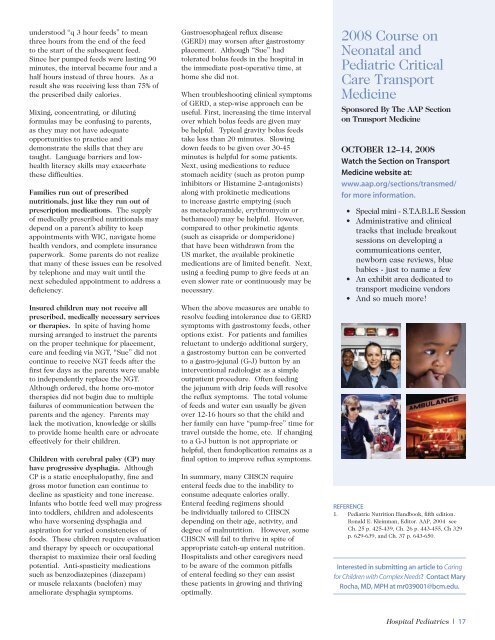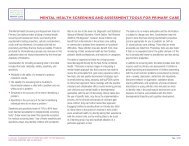Susan Wu, MD, FAAP, Editor - American Academy of Pediatrics
Susan Wu, MD, FAAP, Editor - American Academy of Pediatrics
Susan Wu, MD, FAAP, Editor - American Academy of Pediatrics
You also want an ePaper? Increase the reach of your titles
YUMPU automatically turns print PDFs into web optimized ePapers that Google loves.
understood “q 3 hour feeds” to mean<br />
three hours from the end <strong>of</strong> the feed<br />
to the start <strong>of</strong> the subsequent feed.<br />
Since her pumped feeds were lasting 90<br />
minutes, the interval became four and a<br />
half hours instead <strong>of</strong> three hours. As a<br />
result she was receiving less than 75% <strong>of</strong><br />
the prescribed daily calories.<br />
Mixing, concentrating, or diluting<br />
formulas may be confusing to parents,<br />
as they may not have adequate<br />
opportunities to practice and<br />
demonstrate the skills that they are<br />
taught. Language barriers and lowhealth<br />
literacy skills may exacerbate<br />
these difficulties.<br />
Families run out <strong>of</strong> prescribed<br />
nutritionals, just like they run out <strong>of</strong><br />
prescription medications. The supply<br />
<strong>of</strong> medically prescribed nutritionals may<br />
depend on a parent’s ability to keep<br />
appointments with WIC, navigate home<br />
health vendors, and complete insurance<br />
paperwork. Some parents do not realize<br />
that many <strong>of</strong> these issues can be resolved<br />
by telephone and may wait until the<br />
next scheduled appointment to address a<br />
deficiency.<br />
Insured children may not receive all<br />
prescribed, medically necessary services<br />
or therapies. In spite <strong>of</strong> having home<br />
nursing arranged to instruct the parents<br />
on the proper technique for placement,<br />
care and feeding via NGT, “Sue” did not<br />
continue to receive NGT feeds after the<br />
first few days as the parents were unable<br />
to independently replace the NGT.<br />
Although ordered, the home oro-motor<br />
therapies did not begin due to multiple<br />
failures <strong>of</strong> communication between the<br />
parents and the agency. Parents may<br />
lack the motivation, knowledge or skills<br />
to provide home health care or advocate<br />
effectively for their children.<br />
children with cerebral palsy (cP) may<br />
have progressive dysphagia. Although<br />
CP is a static encephalopathy, fine and<br />
gross motor function can continue to<br />
decline as spasticity and tone increase.<br />
Infants who bottle feed well may progress<br />
into toddlers, children and adolescents<br />
who have worsening dysphagia and<br />
aspiration for varied consistencies <strong>of</strong><br />
foods. These children require evaluation<br />
and therapy by speech or occupational<br />
therapist to maximize their oral feeding<br />
potential. Anti-spasticity medications<br />
such as benzodiazepines (diazepam)<br />
or muscle relaxants (bacl<strong>of</strong>en) may<br />
ameliorate dysphagia symptoms.<br />
Gastroesophageal reflux disease<br />
(GERD) may worsen after gastrostomy<br />
placement. Although “Sue” had<br />
tolerated bolus feeds in the hospital in<br />
the immediate post-operative time, at<br />
home she did not.<br />
When troubleshooting clinical symptoms<br />
<strong>of</strong> GERD, a step-wise approach can be<br />
useful. First, increasing the time interval<br />
over which bolus feeds are given may<br />
be helpful. Typical gravity bolus feeds<br />
take less than 20 minutes. Slowing<br />
down feeds to be given over 30-45<br />
minutes is helpful for some patients.<br />
Next, using medications to reduce<br />
stomach acidity (such as proton pump<br />
inhibitors or Histamine 2-antagonists)<br />
along with prokinetic medications<br />
to increase gastric emptying (such<br />
as metaclopramide, erythromycin or<br />
bethanecol) may be helpful. However,<br />
compared to other prokinetic agents<br />
(such as cisapride or domperidone)<br />
that have been withdrawn from the<br />
US market, the available prokinetic<br />
medications are <strong>of</strong> limited benefit. Next,<br />
using a feeding pump to give feeds at an<br />
even slower rate or continuously may be<br />
necessary.<br />
When the above measures are unable to<br />
resolve feeding intolerance due to GERD<br />
symptoms with gastrostomy feeds, other<br />
options exist. For patients and families<br />
reluctant to undergo additional surgery,<br />
a gastrostomy button can be converted<br />
to a gastro-jejunal (G-J) button by an<br />
interventional radiologist as a simple<br />
outpatient procedure. Often feeding<br />
the jejunum with drip feeds will resolve<br />
the reflux symptoms. The total volume<br />
<strong>of</strong> feeds and water can usually be given<br />
over 12-16 hours so that the child and<br />
her family can have “pump-free” time for<br />
travel outside the home, etc. If changing<br />
to a G-J button is not appropriate or<br />
helpful, then fundoplication remains as a<br />
final option to improve reflux symptoms.<br />
In summary, many CHSCN require<br />
enteral feeds due to the inability to<br />
consume adequate calories orally.<br />
Enteral feeding regimens should<br />
be individually tailored to CHSCN<br />
depending on their age, activity, and<br />
degree <strong>of</strong> malnutrition. However, some<br />
CHSCN will fail to thrive in spite <strong>of</strong><br />
appropriate catch-up enteral nutrition.<br />
Hospitalists and other caregivers need<br />
to be aware <strong>of</strong> the common pitfalls<br />
<strong>of</strong> enteral feeding so they can assist<br />
these patients in growing and thriving<br />
optimally.<br />
2008 Course on<br />
Neonatal and<br />
Pediatric Critical<br />
Care Transport<br />
Medicine<br />
sponsored by the AAP section<br />
on transport Medicine<br />
OctObEr 12–14, 2008<br />
Watch the Section on Transport<br />
Medicine website at:<br />
www.aap.org/sections/transmed/<br />
for more information.<br />
• Special mini - S.T.A.B.L.E Session<br />
• Administrative and clinical<br />
tracks that include breakout<br />
sessions on developing a<br />
communications center,<br />
newborn case reviews, blue<br />
babies - just to name a few<br />
• An exhibit area dedicated to<br />
transport medicine vendors<br />
• And so much more!<br />
REFERENCE<br />
1. Pediatric Nutrition Handbook, fifth edition.<br />
Ronald E. Kleinman, <strong>Editor</strong>. AAP, 2004 see<br />
Ch. 25 p. 425-439, Ch. 26 p. 443-455, Ch 329<br />
p. 629-639, and Ch. 37 p. 643-650.<br />
Interested in submitting an article to Caring<br />
for Children with Complex Needs? Contact Mary<br />
Rocha, <strong>MD</strong>, MPH at mr039001@bcm.edu.<br />
Hospital <strong>Pediatrics</strong> | 17



